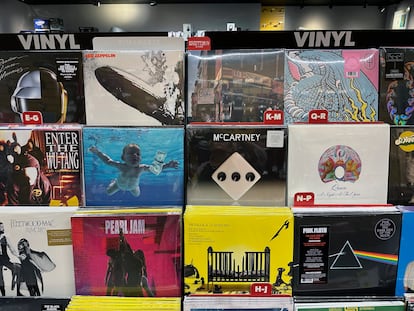New pop stars turn vinyl sales upside down
Taylor Swift, Rosalía and Harry Styles have revolutionized a market until now dominated by classicism and the underground

It has been almost a decade since the music industry managed to dust off vinyl from its trunk of memories. The sector has grown steadily since 2013, when 140,000 vinyl records were sold in Spain, compared to over 1.5 million in 2022. The situation is similar in countries such as the UK, where in the last few weeks of 2023 Taylor Swift and The Rolling Stones sold more than 250,000 records between them. Swift last year accounted for 7% of vinyl sales in the entire country. Once thought obsolete, vinyl has become a must-have object for fans.
If there is something in common between the new versions of her catalog that Taylor Swift is recording and releasing — 1989 (Taylor’s Version) was the most sold vinyl in Spain in 2023 — and the latest albums by Aitana, C. Tangana, Rosalía, Olivia Rodrigo and Harry Styles, is that they top the list of best-selling vinyls in Spain last year, according to the Spanish Music Producers Association (Promusicae), signaling a true stylistic shift in the vinyl market in the 21st century.
The best-sellers over the last decade in Spain are Rumours (1977), by Fleetwood Mac, followed by The Dark Side of the Moon (1973), by Pink Floyd, and Abbey Road (1969), by The Beatles. No artist has sold more vinyl records in the world in the 21st century than David Bowie. This format, then, is no longer just a nostalgic niche — the only current band that sneaks into the best-selling vinyl charts is Arctic Monkeys — and has become a new playing field for the new pop stars enter to compete, and sell, on. “People aren’t buying the record to listen to it again. Now it’s a collector’s item,” says Miguel Ángel Sánchez, president of the Independent Phonographic Union (UFI). According to a study by Luminate, a U.S. company specializing in data analysis related to the music world, 50% of vinyl record buyers in the U.S. did not own a record player.
“Although there are many people who still buy them to listen to them, others buy them as a testimonial record. They hang the vinyl on the wall of their homes,” says José Luis Fernández, of the Discos Killers record store in Madrid. Stores of this kind that have stood the test of time are today visited almost in the same way as a museum. Classics of late 20th-century music such as Bob Dylan, Eric Clapton or Bruce Springsteen hang on their walls. The difference is that now they are joined by Motomami, by Rosalía; Cowboys de la A3, by Arde Bogotá, or Bellodrama, by Ana Mena.
The vinyl factories, which closed in the 1990s in the face of falling sales and the rise of CDs, have now been taken over by the main industry players. “When the major labels realized that LPs were now cult objects, they took over the raw materials and the market for pressings,” explains Sánchez. The problem, he says, is the shortage of factories in Spain — and the few that other vinyl-producing countries remaining such as Holland and the Czech Republic — and the production queue that has generated the boom in multinational music production in this format. As music journalist Ben Sisario predicted in The New York Times in a report on vinyl sales in 2021: “They may end up becoming just another merchandising object.”
Sign up for our weekly newsletter to get more English-language news coverage from EL PAÍS USA Edition
Tu suscripción se está usando en otro dispositivo
¿Quieres añadir otro usuario a tu suscripción?
Si continúas leyendo en este dispositivo, no se podrá leer en el otro.
FlechaTu suscripción se está usando en otro dispositivo y solo puedes acceder a EL PAÍS desde un dispositivo a la vez.
Si quieres compartir tu cuenta, cambia tu suscripción a la modalidad Premium, así podrás añadir otro usuario. Cada uno accederá con su propia cuenta de email, lo que os permitirá personalizar vuestra experiencia en EL PAÍS.
¿Tienes una suscripción de empresa? Accede aquí para contratar más cuentas.
En el caso de no saber quién está usando tu cuenta, te recomendamos cambiar tu contraseña aquí.
Si decides continuar compartiendo tu cuenta, este mensaje se mostrará en tu dispositivo y en el de la otra persona que está usando tu cuenta de forma indefinida, afectando a tu experiencia de lectura. Puedes consultar aquí los términos y condiciones de la suscripción digital.
More information
Archived In
Últimas noticias
Aquilino Gonell, former Capitol sergeant: ‘If it hadn’t been for the police, the US would be a dictatorship’
A hybrid building: Soccer pitch, housing, and a shopping mall
Europe urges Trump to respect Greenland following annexation threats
Science seeks keys to human longevity in the genetic mixing of Brazilian supercentenarians
Most viewed
- Alain Aspect, Nobel laureate in physics: ‘Einstein was so smart that he would have had to recognize quantum entanglement’
- Mexico’s missing people crisis casts a shadow over World Cup venue
- Why oil has been at the center of Venezuela-US conflicts for decades
- Alvin Hellerstein, a 92-year-old judge appointed by Bill Clinton, to preside over Maduro’s trial in New York
- Cuba confirms death of 32 of its citizens in the US attack against Venezuela










































